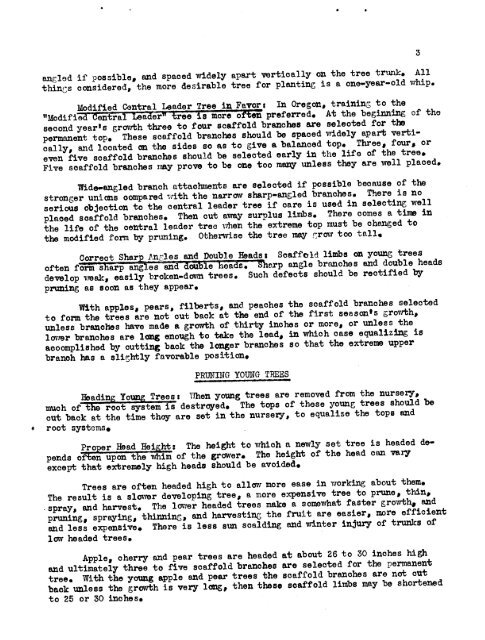Pruning suggestions for fruit trees.pdf
Pruning suggestions for fruit trees.pdf
Pruning suggestions for fruit trees.pdf
You also want an ePaper? Increase the reach of your titles
YUMPU automatically turns print PDFs into web optimized ePapers that Google loves.
angled if possible, and spaced widely apart vertically on the tree trunk, All<br />
things considered, the more desirable tree <strong>for</strong> plariting is a one..year-old whip.<br />
Modified Central Leader Tree in Favor: In Oregon, training to the<br />
"Modified ditzaTIóaderTT ree ii more of preferred. At the beginning of the<br />
second year's gravth three to four scaffold branches are selected <strong>for</strong> the<br />
permanent top. These scaffold branches should be spaoed widely apart verti-<br />
cally, and located on the sides so as to give a balanced top. Threes four, or<br />
even five scaffold branches should be selected early in the life of the tree.<br />
Five scaffold branches may prove to be one too many unless they are well placed.<br />
Wide'angled branch attachments are selected if possible because of the<br />
stronger unions compared rith the narrow sharp-angled branches. There is no<br />
serious objection to the central leader tree if care is used in selecting well<br />
placed scaffold branches. Then cut away surplus limbs. There comes a time in<br />
the life of the central leader tree when the extreme top must be ohanged to<br />
the modified <strong>for</strong>m by pruning. Otherwise the tree may grow too tall,<br />
Correct SharJ.ngles arid Double Heads: Soaffc,ld limbs on young <strong>trees</strong><br />
often <strong>for</strong>ii iharp anges iiU&óüble headiSharp angle branches and double heads<br />
develop weak, easily broken-dowri <strong>trees</strong>.<br />
Such defects should be rectified by<br />
pruning as soon as they appear.<br />
With apples, pears, filberts, and peaches the scaffold branches selected<br />
to <strong>for</strong>m the <strong>trees</strong> are ot cut back at the end of the first seasonts growth,<br />
unless branches have made a growth of thirty inches or more, or unless the<br />
lower branches are long enough to take the lead, in which case equalizing is<br />
longer branches so that the extreme upper<br />
accomplished by cutting back the<br />
branch has a slightly favorable position.<br />
PRUNING YOUNG TREES<br />
Headiug Young Trees: Then young <strong>trees</strong> are removed from the nursery,<br />
much of the root system is destroyed. The tops of these young <strong>trees</strong> should be<br />
cut back at the time they are set in the nursery, to equalize the tops and<br />
root systoms.<br />
Proper Head Height: The height to which a newly set tree is headed depends<br />
often upon the whiii of the grower. The height of the head can vary<br />
except that extremely high heads should be avoided,<br />
Trees are often headed high to allow more ease in working about them.<br />
The result is a slower developing tree, a more expensive tree to prune, thin,<br />
spray, and harvest. The lower headed <strong>trees</strong> make a somewhat faster growth, and<br />
pruning, spraying, thinning, arid<br />
harvesting the <strong>fruit</strong> are easier, more effie lent<br />
and less expensive. There is less sun scalding and winter injury of trunks of<br />
low headed <strong>trees</strong>,<br />
Apple, cherry arid pear <strong>trees</strong> are headed at about 26 to 30 inches high<br />
and ultimately three to five scaffold branches are selected <strong>for</strong> the permanent<br />
tree. With the young apple and pear <strong>trees</strong> the scaffold brariohes are not out<br />
back unless the growth is very long, then these scaffold limbs may be shortened<br />
to 25 or 30 inches.<br />
3
















